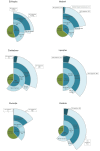Who are the missing men? Characterising men who never tested for HIV from population-based surveys in six sub-Saharan African countries
- PMID: 31631576
- PMCID: PMC6801221
- DOI: 10.1002/jia2.25398
Who are the missing men? Characterising men who never tested for HIV from population-based surveys in six sub-Saharan African countries
Abstract
Introduction: We sought to characterize men who had never tested for HIV, understand factors associated with not testing, and measure survey HIV test uptake among never testers. We analysed nationally representative Demographic and Health Surveys of six African countries from 2013 to 2016: Ethiopia, Malawi, Zimbabwe, Rwanda, Lesotho and Zambia.
Methods: Eligible men were household residents or overnight visitors aged 15 to 59 years. We analysed questionnaire responses on HIV testing, known behavioural risk factors, and corresponding HIV laboratory results. We used survey-weighted logistic regression to identify factors associated with never testing for HIV.
Results: Approximately double the proportion of men had never tested for HIV compared to women (Malawi: 30% vs. 17%, p < 0.0001; Zimbabwe: 35% vs. 19%, p < 0.0001; Lesotho: 34% vs. 15%, p < 0.0001; Zambia: 36% vs. 20%, p < 0.0001); although, less of a differential existed in Ethiopia (54% vs. 56%, p = 0.12) and Rwanda (19% vs. 14%, p < 0.0001). When offered a test during the survey, 85% to 99% of sexually active men who reported never previously testing, accepted testing. HIV positivity ranged from <0.05% to 14% for never tested men. After adjusting for age, factors associated with never having tested for HIV were never being married (aOR range: 1.46 to 10.39), not having children (aOR: 1.36 to 3.59) and lower education (less than primary education aOR: 2.77 to 5.59).
Conclusions: Although higher proportions of men than women had never tested for HIV, 85% to 99% of men did accept a test when offered. Finding opportunities to offer HIV testing to single men without children, older men who have never tested, and those disadvantaged with less schooling and employment, alongside other facility and community-based services, will be important in identifying those living with undiagnosed HIV and improving men's health.
Keywords: Africa South of the Sahara; HIV testing; HIV/AIDS; Health surveys; men.
© 2019 The Authors. Journal of the International AIDS Society published by John Wiley & Sons Ltd on behalf of the International AIDS Society.
Figures
References
-
- Joint United Nations Programme on HIV/AIDS . Miles to go closing gaps, breaking barriers, righting injustices – global AIDS update. Geneva: Joint United Nations Programme on HIV/AIDS (UNAIDS); 2018.
-
- The Lancet . Gender and health are also about boys and men. Lancet. 2018;392(10143):188. - PubMed
-
- World Health Organization . Consolidated guidelines on HIV testing services. Geneva: World Health Organization; 2015. - PubMed
-
- Teo CH, Ng CJ, Booth A, White A. Barriers and facilitators to health screening in men: a systematic review. Soc Sci Med. 2016;165:168–76. - PubMed
Publication types
MeSH terms
Grants and funding
LinkOut - more resources
Full Text Sources
Medical



